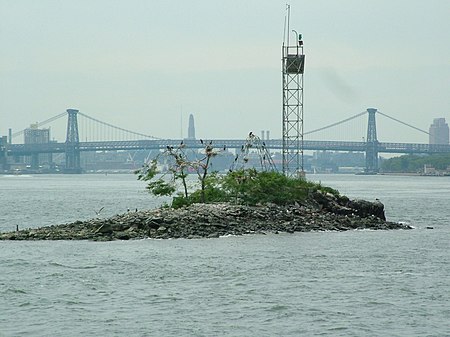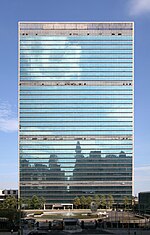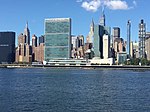The United Nations is headquartered in Midtown Manhattan, New York City, United States, and the complex has served as the official headquarters of the United Nations since its completion in 1951. It is in the Turtle Bay neighborhood of Manhattan, on 17 to 18 acres (6.9 to 7.3 ha) of grounds overlooking the East River. Its borders are First Avenue on the west, East 42nd Street to the south, East 48th Street on the north, and the East River to the east. The complex consists of several structures, including the Secretariat, Conference, and General Assembly buildings and the Dag Hammarskjöld Library. The complex was designed by a board of architects led by Wallace Harrison and built by the architectural firm Harrison & Abramovitz, with final projects developed by Oscar Niemeyer and Le Corbusier. The term Turtle Bay is occasionally used as a metonym for the UN headquarters or for the United Nations as a whole.The headquarters holds the seats of the principal organs of the UN, including the General Assembly and the Security Council, but excluding the International Court of Justice, which is seated in The Hague. The United Nations has three additional subsidiary regional headquarters, or headquarters districts. These were opened in Geneva (Switzerland) in 1946, Vienna (Austria) in 1980, and Nairobi (Kenya) in 1996. These adjunct offices help represent UN interests, facilitate diplomatic activities, and enjoy certain extraterritorial privileges, but do not contain the seats of major organs.
Although it is physically situated in New York City, the land occupied by the United Nations Headquarters and the spaces of buildings that it rents are under the sole administration of the United Nations and not the U.S. government. They are technically extraterritorial through a treaty agreement with the U.S. government. However, in exchange for local police, fire protection, and other services, the United Nations agrees to acknowledge most local, state, and federal laws.None of the United Nations' 15 specialized agencies (such as UNESCO) are located at the headquarters. However, some "autonomous subsidiary organs", such as UNICEF, have their headquarters at the UNHQ.









